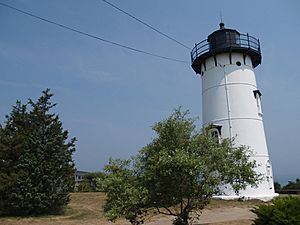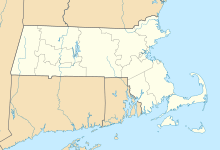East Chop Light facts for kids
 |
|
|
|
|
| Location | Lighthouse Road, Oak Bluffs, Massachusetts |
|---|---|
| Coordinates | 41°28′12.95″N 70°34′2.825″W / 41.4702639°N 70.56745139°W |
| Year first constructed | 1869 |
| Year first lit | 1878 (current structure) |
| Automated | 1933 |
| Foundation | Concrete |
| Construction | Cast Iron |
| Tower shape | Conical |
| Markings / pattern | White with black lantern |
| Height | 40 feet (12 m) |
| Focal height | 79 feet (24 m) |
| Original lens | 12 inches (300 mm) |
| Range | 9 nautical miles (17 km; 10 mi) |
| Characteristic | Isophase Green 6s |
| Fog signal | none |
| Admiralty number | J0446 |
| ARLHS number | USA-259 |
| USCG number | 1-13745 |
The East Chop Light is a historic lighthouse located on a tall cliff. It looks out over Vineyard Haven Harbor and Vineyard Sound. You can find it along East Chop Drive in Oak Bluffs, Massachusetts. This lighthouse is one of five important lighthouses on the island of Martha's Vineyard.
Contents
History of East Chop Light
The East Chop Light was built in 1878. It was added to the National Register of Historic Places in 1987. Before the lighthouse, this spot was called "Telegraph Hill." This was because a signal station, like a flag tower, stood there in the early 1800s.
First Lighthouses and Changes
Around 1869, a local merchant named Captain Silas Daggett built a private lighthouse here. He charged fees to ship owners and businesses to help pay for it. This was the last of six lighthouses built on Martha's Vineyard.
Sadly, Daggett's first lighthouse, which used oil, burned down in 1871. He rebuilt it in 1872. This new light looked like a house with a lantern room sticking out. It showed a red light and used kerosene lamps.
In 1875, the United States government bought the property for $6,000. They removed Daggett's buildings. In 1878, the lighthouse you see today was built. It's a strong, cone-shaped tower made of cast iron. It also had a special lens called a fourth-order Fresnel lens.
Color Changes and Automation
The lighthouse was first painted white. But in the 1880s, it was painted a reddish-brown color. Many people loved this color and called it the "Chocolate Lighthouse."
In 1933, the East Chop Light became automated. This meant it no longer needed a keeper to live there and operate it. The keeper's house and other small buildings were then torn down. After this, the lighthouse was closed to the public.
Saving the Lighthouse
From 1878 until the early 1980s, the United States Coast Guard took care of the East Chop Light. However, in the 1970s and 1980s, the Coast Guard faced money problems. Because of this, many lighthouses across the U.S. were planned to be destroyed. This was also because new technology like GPS made lighthouses less important for guiding ships.
Community Action to Protect Lighthouses
The East Chop Light, along with two other Martha's Vineyard lighthouses (Gay Head Light and Edgartown Harbor Light), was set to be destroyed. But people on the island worked hard to save them. William Waterway Marks and John F. Bitzer, Jr., from the Vineyard Environmental Research Institute (VERI), spoke to Congress. They got support from politicians like Congressman Gerry Studds and Senator Ted Kennedy.
Because of these efforts, the Coast Guard gave VERI a 35-year license for the three lighthouses in 1985. This was a big deal! It was the first time in U.S. history that civilian groups were allowed to manage active lighthouses. It was also the first time an island group managed a lighthouse on Martha's Vineyard.
Restoration and New Paint Job
VERI started raising money to fix up the lighthouses. Many people from Martha's Vineyard helped, including local supporters and famous people. These events helped raise money for a big restoration of the East Chop Light.
In 1988, VERI changed the lighthouse's color back to white. This was its original color from 1878. They found that the dark reddish-brown paint made the cast iron tower too hot. This caused moisture inside, leading to rust and damage to the wood walls. Changing it back to white helped protect the lighthouse.
Public Access Today
After the lighthouse became automated in 1933, it was closed to the public for 55 years. In 1988, VERI opened the East Chop Light for limited public visits. They made many safety changes inside and outside the lighthouse first.
Now, the lighthouse is open to the public every Sunday during the summer. It is also open for special events like weddings and fundraisers. The Martha's Vineyard Museum now manages this public access.
Lighthouse Management Transfer
In 1994, VERI transferred the licenses for the three lighthouses to the Martha's Vineyard Historical Society (MVHS). This group is now known as the Martha's Vineyard Museum. William Waterway Marks, who helped save the lighthouses, also became the first chairman of the MVHS Lighthouse Committee.
The Martha's Vineyard Museum has been taking care of the three lighthouses since 1994. The United States Coast Guard still owns the buildings. In 2003, the Museum paid for an expert to check all three lighthouses. In 2007, the East Chop Lighthouse was fully refurbished. It got new electrical wiring, new windows, and a fresh exterior.
East Chop Light Today
Today, the East Chop Light is described by the United States Coast Guard as a "White tower." Its light shines 79 feet (24 m) above the water. Thanks to the care of the Martha's Vineyard community, the East Chop Light continues to stand tall. It is an important symbol of the island's rich history with the sea. In 1987, the East Chop Light was officially added to the National Register of Historic Places.
East Chop Light Keepers
- Silas Daggett (private owner 1869-1878)
- George Silvey (1876-1898)
- George H. Fisher (1898-1902)
- George Walter Purdy (1902-1934)
- William Waterway Marks (Principal Keeper 1985-1994)
- Bill Brown (Assistant Keeper 1985-1988)
- Della Hardman (Assistant Keeper 1987-1990)
- Elizabeth Talbot (Assistant Keeper 1985-1992)


